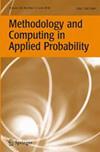离散时间风险过程中作为复发序列的毁灭概率
IF 1
4区 数学
Q3 STATISTICS & PROBABILITY
Methodology and Computing in Applied Probability
Pub Date : 2024-08-20
DOI:10.1007/s11009-024-10102-0
引用次数: 0
摘要
应用线性递推序列理论得到了离散时间风险过程中最终毁灭概率的明确公式。假设索赔分布是任意的,但有有限的支持(\varvec\{0,1,\ldots ,m+1\}}),对于某个整数(\varvec{m\ge 1}\)。该方法需要找到 m 度多项式的零点,并求解 m 个线性方程组。该方法得出了一个近似值,并提供了一些数值结果和图例。本文章由计算机程序翻译,如有差异,请以英文原文为准。

Ruin Probabilities as Recurrence Sequences in a Discrete-Time Risk Process
The theory of linear recurrence sequences is applied to obtain an explicit formula for the ultimate ruin probability in a discrete-time risk process. It is assumed that the claims distribution is arbitrary but has finite support \(\varvec{\{0,1,\ldots ,m+1\}}\), for some integer \(\varvec{m\ge 1}\). The method requires finding the zeroes of an m degree polynomial and solving a system of m linear equations. An approximation is derived and some numerical results and plots are provided as examples.
求助全文
通过发布文献求助,成功后即可免费获取论文全文。
去求助
来源期刊
CiteScore
1.70
自引率
0.00%
发文量
58
审稿时长
6-12 weeks
期刊介绍:
Methodology and Computing in Applied Probability will publish high quality research and review articles in the areas of applied probability that emphasize methodology and computing. Of special interest are articles in important areas of applications that include detailed case studies. Applied probability is a broad research area that is of interest to many scientists in diverse disciplines including: anthropology, biology, communication theory, economics, epidemiology, finance, linguistics, meteorology, operations research, psychology, quality control, reliability theory, sociology and statistics.
The following alphabetical listing of topics of interest to the journal is not intended to be exclusive but to demonstrate the editorial policy of attracting papers which represent a broad range of interests:
-Algorithms-
Approximations-
Asymptotic Approximations & Expansions-
Combinatorial & Geometric Probability-
Communication Networks-
Extreme Value Theory-
Finance-
Image Analysis-
Inequalities-
Information Theory-
Mathematical Physics-
Molecular Biology-
Monte Carlo Methods-
Order Statistics-
Queuing Theory-
Reliability Theory-
Stochastic Processes

 求助内容:
求助内容: 应助结果提醒方式:
应助结果提醒方式:


